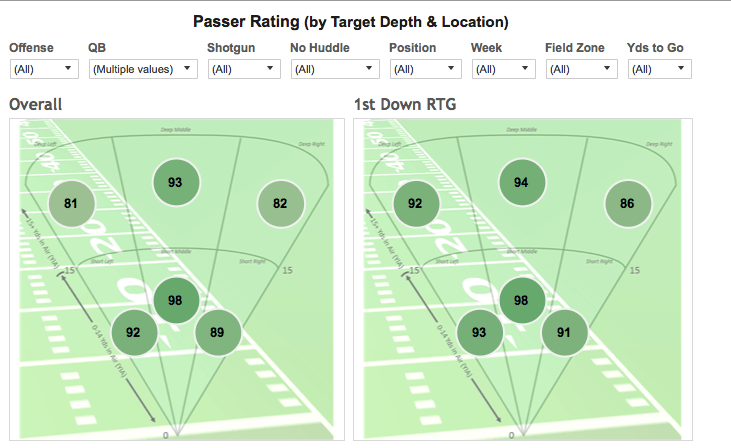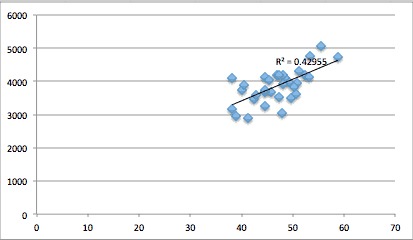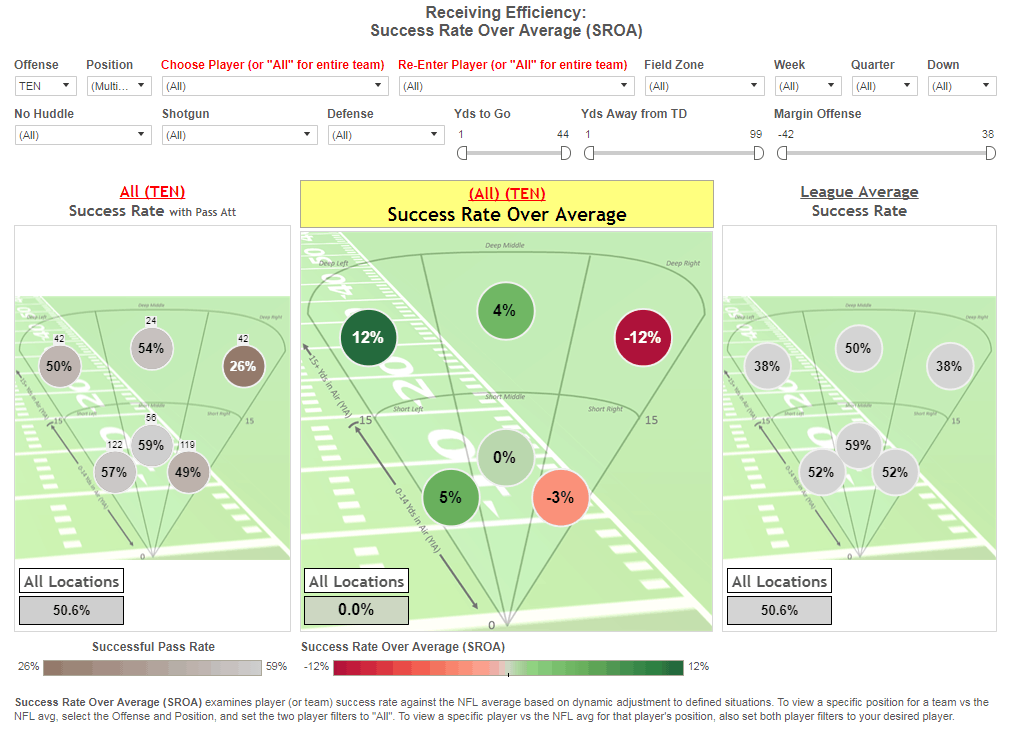The NFL is a game of creating mismatches, and find ways to exploit them in both the run and the pass game. Run games are about creating a numbers game advantage to a particular side, and trusting your running back to make one man miss in most schemes. The passing game, however, suffers from playing at a numbers disadvantage on most plays, as everyone pre-snap knows the number of eligible receivers. Typically, the passing game creates mismatches in a variety of ways. Whether it is through play action, speed of receivers, size of tight ends or wideouts, or simply through play design, NFL teams work to exploit mismatches throughout the game. Last year, 4.51 players went out in pass routes on passing plays, so in rough terms, 1 of every two plays will feature an extra pass blocker, while all five eligible receivers (combination of wide receivers, tight ends and running backs) will be out in patterns on the other.
Some teams will even avoid the best corner on another team depending on their reputation and what they have put on film in previous games. Aaron Rodgers has done this numerous times in his tilts against Richard Sherman and Seattle as well as in other matchups throughout the league. Shadow corners are rare in todays NFL with just a handful of players tasked with following around an opponents top wideouts, the ones that do though are typically worth avoiding. Among all corners who saw at least 400 snaps in coverage last season, just 17 of them allowed a pass rating of sub-80 into their coverage according to Pro Football Focus.
So how else can offenses pass the ball more efficiently in this day and age? Well one idea is to attack the backside of the defense typically covered by a defenses second corner. Commonly, a team’s top corner will lineup in what is typically referred to as the left cornerback or strong side corner as most quarterbacks are typically right handed. In the NFL today, there is only one quarterback who throws with his left hand and that is Kellen Moore, and for the sake of good football, let’s hope we don’t have to watch him play on Sunday’s anytime soon. The rest of the league’s quarterbacks are all right handed and primed to attack the left side of the field on backside in-breaking routes. Tom Brady is a master of the quick shotgun fake to the running back to pull up the linebackers before quick striking a slant on the backside for chunk plays, but that’s just narrative, so lets examine the metrics in depth.
 While passing to the short left and right each have similar success rate percentages in relation to league average (at 50% success rates each), there are some signs that attacking the backside is more effective. Using one of our tools, Passer Rating (by Target Depth & Location), we can examine the passer rating for each zone on the field. Passing short left yielded a 3% greater passer-rating league wide than short right, and an even starker contrast on third down where short left yields a passer rating of 87 compared to 81 when throwing short right. Now lets use this tool's dynamic updating to look at some other statistics like yards per attempt and completion percentage.
While passing to the short left and right each have similar success rate percentages in relation to league average (at 50% success rates each), there are some signs that attacking the backside is more effective. Using one of our tools, Passer Rating (by Target Depth & Location), we can examine the passer rating for each zone on the field. Passing short left yielded a 3% greater passer-rating league wide than short right, and an even starker contrast on third down where short left yields a passer rating of 87 compared to 81 when throwing short right. Now lets use this tool's dynamic updating to look at some other statistics like yards per attempt and completion percentage.
 On all passing plays, short left yielded a completion percentage of 1% higher than that of short right. Looking at yards per attempt yields a .35 higher total for short left than short right. Touchdown rates are nearly identical no matter the side of throw with short right having just a .006% advantage. Interception rate is slightly better for short left, over the course of 6,140 attempts to the short right, it would shave about 3 interceptions off the 82 thrown in that direction. There are signs that teams need to throw more to the backside than the front side that is attacked on 3% more of all attempts.
On all passing plays, short left yielded a completion percentage of 1% higher than that of short right. Looking at yards per attempt yields a .35 higher total for short left than short right. Touchdown rates are nearly identical no matter the side of throw with short right having just a .006% advantage. Interception rate is slightly better for short left, over the course of 6,140 attempts to the short right, it would shave about 3 interceptions off the 82 thrown in that direction. There are signs that teams need to throw more to the backside than the front side that is attacked on 3% more of all attempts.
Let's look at a few examples from 2016. For this analysis, let's ignore passes to RBs, even though those are extremely strong plays which should be utilized more often. Looking only at passes to WRs and TEs, there are several young quarterbacks who excelled throwing to their backside (short left) but who need their coaches to call more plays to maximize targets to that location. Marcus Mariota posted a 8% stronger success rate short left as compared to short right, yet he threw almost equally (122 att vs 119 att) to the short left as he did to the short right. Dak Prescott was 12% above average throwing to the short left, and his success rate was 3% better to the short left than the short right. He posted a 113 passer rating short left vs a 93 passer rating short right. Yet he threw threw 154 times to the short right (to WRs and TEs) and only 111 times to the short left.
In addition to attacking the left, teams should continue to attack the middle of defenses. Attacking the middle of defenses both short and long yields the highest passer ratings in their sets. In terms of league wide success rate, attacking short middle is six percent more effective than attacking either side of the field. When throwing deep, teams are successful 50% of the time over the middle, but when going deep left just 37% of the time and 38% to the right. Short and deep middle also produces significantly higher completion percentages, yards per attempts, and touchdown percentages than compared to either direction. Offenses need to continue to find players that can help them over the middle as the tight end position is becoming more and more of a pass catching threat. Overall, a teams success rate is correlated to passing yards in a big way, as seen in the below chart.
 NFL teams can flip their top wide receiver to the other side of the formation (if he's productive in on that side of the field) in order to use their skill sets in a more efficient manner. All pass catchers can work on getting more comfortable over the middle, as when this area is attacked it typically yields big results for the passer and the receiver. Each team can examine their past success rates to different areas of the field and increase their efficiency by spreading their pass attempts more to the right side, even if it is sometimes to the disdain of their number one receiver. In a never ending quest to increase efficiencies of passing games, teams can continue to scheme how to get players open to all sides of the field, but attacking the left and middle of the field can help teams be even more efficient.
NFL teams can flip their top wide receiver to the other side of the formation (if he's productive in on that side of the field) in order to use their skill sets in a more efficient manner. All pass catchers can work on getting more comfortable over the middle, as when this area is attacked it typically yields big results for the passer and the receiver. Each team can examine their past success rates to different areas of the field and increase their efficiency by spreading their pass attempts more to the right side, even if it is sometimes to the disdain of their number one receiver. In a never ending quest to increase efficiencies of passing games, teams can continue to scheme how to get players open to all sides of the field, but attacking the left and middle of the field can help teams be even more efficient.
About the author: Anthony Staggs (follow: @PyroStag) was crowned co-winner of the Sharp Football Stats 2017 Writing Contest. He will share articles featuring his analysis throughout the 2017 NFL
















